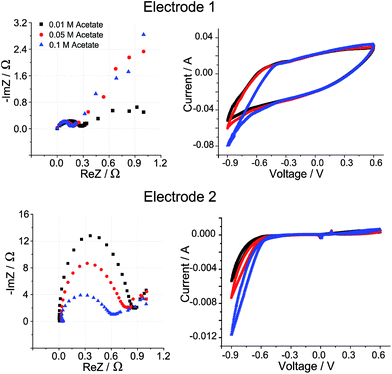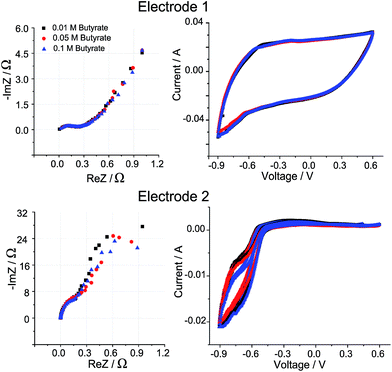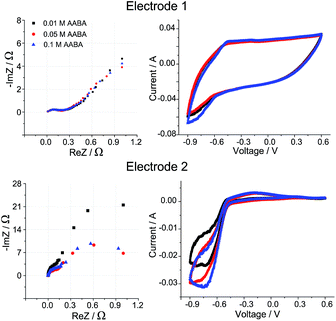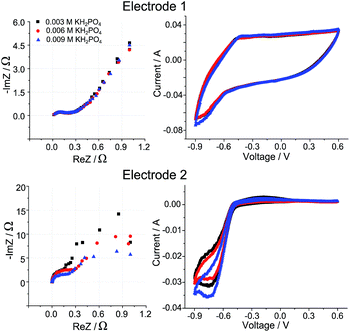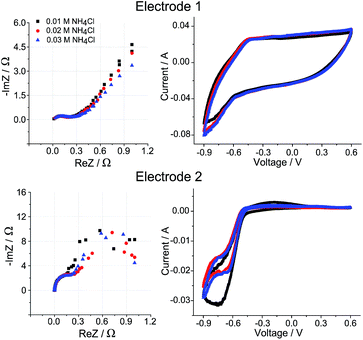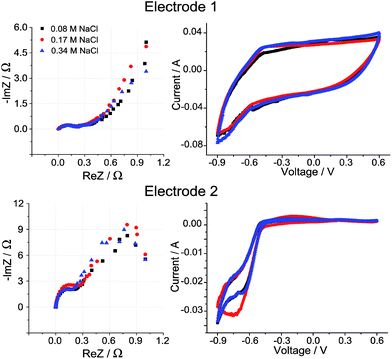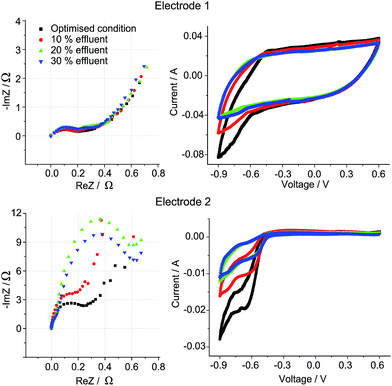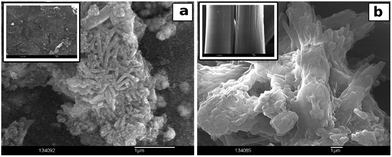Optimization of electrochemical parameters for sulfate-reducing bacteria (SRB) based biocathode
Mohita Sharma†
abc,
Priyangshu M. Sarma*ab,
Deepak Pantc and
Xochitl Dominguez-Benetton*c
aTERI University, Plot No. 10, Institutional Area, Vasant Kunj, New Delhi, 110070, India. E-mail: priyanms@teri.res.in; priyangshumsarma@yahoo.co.in
bThe Energy and Resource Institute (TERI), IHC, Lodhi Road, New Delhi, 110003, India
cSeparation & Conversion Technologies, VITO – Flemish Institute for Technological Research, Boeretang 200, 2400 Mol, Belgium. E-mail: xoch@vito.be
First published on 24th April 2015
Abstract
This study focuses on the effect of operational and physiochemical factors on a stable sulfate reducing bacteria biocathode and their effect on the electrochemical response thereof. Two carbon-based electrode materials i.e. VITO CORE™ and Paxitech® electrodes were evaluated. The electrochemical performance was assessed by changing both organic and inorganic components of the synthetic feed, which included carbon substrates (acetic and butyric acid), ionic strength (concentration of sodium chloride) and weak electrolytes acting as buffering agents (potassium dihydrogen phosphate and ammonium chloride). The concentration of sodium chloride (0.34 M) and acetate (0.1 M) plays a crucial role in determining the performance as well as the bioelectrochemical mechanism of the sulfate reducing bacteria (SRB) biocathode. Butyrate did not significantly influence the performance of the biocathode but showed a synergistic effect when given along with acetate. The developed biocathode was also successfully tested for dark fermentation based effluent treatment application. Concentrations higher than 10% of effluent were found to be detrimental to the electrochemical performance of the biocathode. This study essentially highlights the significance of optimization studies on bioelectrochemical system (BES) at lab scale before its potential upscaling for industrial wastewater processing.
Introduction
Biocathodes are crucial for designing product recovery-oriented bioelectrochemical systems (BES). This need has brought into focus significant research efforts from different perspectives, as the electrochemical activity of these cathodic biofilms can influence the yield and efficiency of targeted electricity driven bioproduction processes.1,2 Sulfate reducing bacteria (SRB) conventionally utilize sulfate as electron acceptor for its metabolism and participate in various biological conversions in sulfur cycle. However, in the current study, this metabolic flexibility of SRB has been utilized for the development of SRB based biocathode. The development of TERI-MS-003 inoculum-based biocathodes and their microbial electrocatalytic capabilities for reduction of organics to value-added chemicals have been elaborately discussed in previous work.3 However, in addition to the selection of electrochemically-active microbes capable of delivering high current densities, the supporting electrode material plays an equally important role.4 Recently, several groups reported the use of improvised electrode materials for economical scale up, like three-dimensional scaffold electrodes which improved bacterial attachment as well as electron transfer,5 in addition to more engineered electrodes like multi-layered corrugated carbon6 which provided long term stability and economical operation. Desloover et al. also emphasized that developing low cost, high surface area and highly conductive electrode materials can address many of the performance related issues existing today, when accompanied with the selection of appropriate biocatalysts.7An important reflection from these previous studies was that the microbe-electrode interface mainly determines the overall reaction efficiency and performance. In addition, BES operation requires continued cultivation and a reproducible outcome, both metabolic and electrochemical, which demand robustness against specific operational changes like pH, temperature, ionic strength, organic feed, shear rate, etc.8 Improvement in BES performance also necessitates accurate characterization of the reproducibility or variability of the electrochemical electrode performance.9 Keeping these essential features in mind, the optimization of selected parameters were conducted during this research.
In the present study, the performance of two different carbon-based electrode materials was evaluated, namely VITO CORE™ (Belgium) and Paxitech® (France). Besides, the effect of changing organic and inorganic components of the synthetic feed was evaluated, including the substrates (acetic and butyric acid), their concentrations, and the ionic strength (regarded as per the concentration of sodium chloride). As it is essential to regulate the electrolyte pH because it directly affects the microbial metabolism and over potential,10 the effect of the concentration of two buffering agents, namely potassium dihydrogen phosphate and ammonium chloride was also assessed in the synthetic feed. Finally, the capability of the biocathodes to treat fermentative effluent stream was also assessed.
The ultimate aim of the present investigation was to determine the key factors regulating the electrochemical performance as well as the preservation of the electrochemical features of the stable SRB biocathode, for which the analysis of the frequency response (impedance) and cyclic voltammetry were paramount.
Experimental
Electrode material
Two carbon-based electrode materials were used for the experiments carried out in this study. Electrode 1 was activated carbon cold-rolled VITO CORE™ electrode, symbolized as E1. The overall characteristics of this type of electrode have been previously described in detail.3 Electrode 2 was a graphitized carbon-based electrode procured from Paxitech® and has been designated as E2. The cell configuration and pre-treatment method used for these electrodes have been elaborately described elsewhere.3 Both electrode materials were cold rolled on a stainless steel mesh.Reactor operation
The schematic in Fig. 1 provides an overview of the cell arrangement and the operational setup for the electrochemical cells used in the current study. These cells were operated simultaneously in continuous mode. The cell set up had an internal loop of recirculation with a 500 mL buffer tank (tank 1 and 2 for E1 and E2, respectively), in addition to a primary buffer tank (T3) that supplied the sterile fresh synthetic feed. The synthetic medium of T3 (wherein each specific parameter to be tested was modified) was used as a common source to simultaneously change the operational conditions in both tanks T1 and T2. Recirculation pumps were installed to improve mass transfer by adjusting electrolyte flow and substrate availability. The flow rate was maintained at 20 mL h−1 during the overall experiment. This provided a hydraulic retention time of 48 h for each parameter that was tested, which ensured a steady state in terms of electrochemical performance (i.e. current density). After 48 h, the electrochemical analysis was conducted using a Biologic multi-potentiostat (software EC-Lab v.10.23).Source of inoculum and electrolyte
TERI-MS-003 consortium was taken from a previously running reactor in the lab as a source of inoculum,3 for both the experimental reactors E1 and E2. The synthetic feed used as electrolyte for running the reactor has been described in previous work.11 Wherever indicated, the concentration of the parameter to be tested was altered in the synthetic feed of T3. The feed was adjusted to pH 5 at the start of each run and all feed tanks T1, T2 and T3 were continuously flushed with sterile nitrogen through a sparger plunged in the electrolyte, during the whole experiment.For the experiments dedicated to demonstrate the capability of the SRB biocathode to treat the organics contained in real effluents, the wastewater stream collected from a 20 L fermenter previously running in the lab (for H2 production through dark fermentation) was tested. This fermentative effluent waste stream was used in 10%, 20% and 30% concentration, respectively, with respect to the synthetic feed and its impact on the SRB biocathode performance was evaluated.
Scanning electron microscopy (SEM)
At the termination of the experiment, after operation of the reactors for over 120 days, the biocathodes were visualized using Scanning Electron Microscopy (SEM). The samples were dipped in 2.5% glutaraldhyde solution overnight at 4 °C. These samples were washed with 0.1 M cold phosphate buffer thrice for 15 minutes each. The samples were dehydrated by using a series of ethanol gradient solutions (30%, 50%, 70%, 80%, 90%, 95% and 100%) for 15 minutes each. The samples were further critical point dried with liquid CO2, mounted on aluminium stubs; sputter coated with platinum–iridium coating and further visualized using JSM6340F, Jeol scanning electron microscope (Japan).Electrochemical evaluation
A three-electrode set-up was used for the electrochemical characterizations. Such setup ensures that the working electrode (in this case the SRB biocathode) is the only rate-limiting step that accounts for the current measured and that the potential applied is rightly controlled.12 The two different working electrodes (E1/E2) were used in their respective reactors (Fig. 1). The reference electrode was Ag/AgCl (3.5 M KCl). All potentials in this manuscript are therefore referred to this electrode. A platinum disc, laser welded on a titanium plate was used as a counter electrode. All connections used here were robust and the reference electrodes were placed in close proximity to their corresponding working electrode to reduce ohmic drop effects down to a negligible level.9 Assessment of the responses of electrochemical impedance spectroscopy (EIS) and cyclic voltammetry (CV) were used to elucidate the reduction mechanism over the microbial electrode interface. Potentiostatic control was maintained for the biocathode throughout its operation at −0.85 V, with a Biologic multi-potentiostat interface (VMP3). Subsequently, upon attaining steady state at this polarization condition (48 h), single-sine EIS was recorded at an AC amplitude of 10 mV, in the frequency range of 100 kHz to 1 mHz. All the EIS data obtained was ohmic drop corrected, normalized and subsequently plotted. CVs with the vertex potentials of 0.6 V to −0.9 V were subsequently conducted in order to obtain mechanistic and phenomenological information of the processes occurring in the system.Calculations
Charge transfer resistance (Rct) was calculated using data from EIS measurements. Rct is inversely proportional to the exchange current (Iex) and the exchange current density per projected area (jex/PSA), which can be calculated using eqn (1),13,14
 | (1) |
![[thin space (1/6-em)]](https://www.rsc.org/images/entities/char_2009.gif) 485.3399 C mol−1). Rct is the charge transfer resistance (Ω m2), which can be obtained from the EIS response and A is the projected surface area (PSA) of the rate-limiting electrode (biocathode here). From the cyclic voltammetry (CV) data, cathodic peak currents were calculated using the EC-Lab software (v 10.23). Data obtained via CV were used to calculate both capacitance and energy using equations described elsewhere.11
485.3399 C mol−1). Rct is the charge transfer resistance (Ω m2), which can be obtained from the EIS response and A is the projected surface area (PSA) of the rate-limiting electrode (biocathode here). From the cyclic voltammetry (CV) data, cathodic peak currents were calculated using the EC-Lab software (v 10.23). Data obtained via CV were used to calculate both capacitance and energy using equations described elsewhere.11
Result and discussion
Evaluation of the physiochemical and operational parameters in continuous mode was conducted to simulate an industrial wastewater treatment setup where water is routinely discharged in a continuous mode. However such an operation may lead to shearing and loss of the electrochemically active biomass over the electrode surface. In order to prevent such an occurrence, an additional element of recirculation (500 mL buffer tank) was directly coupled to the electrochemical cell (T1 and T2, Fig. 1). This not only ensured sufficient biomass within the electrolysis cell, but also provided an adequate hydraulic retention time and stability for the reactor to record electrochemical measurements. The carbon based electrode materials were cold rolled over stainless steel mesh in order to reduce electron transfer losses and subsequently the internal resistance of BES, as also reported by Kong et al.15Electrochemical methods can be effectively applied for in vivo determination of electron transfer processes and characterization of electroactive biofilms, especially when these are not intrusive.16 Formation of electrochemically active biofilms on the electrode surfaces was reckoned by a systematic increase in current density during potentiostatic polarization at −0.85 V. After reaching a steady state in current (established as <±10 μA fluctuation limit in a period of 2 h), potentiostatic EIS was applied to exhibit the electron transfer characteristics of the biocathode; the effect of the variations in the operational factors in the respective EIS parameters is described in the subsequent sections. CV analysis was performed, after a given steady-state condition and EIS measurement, at low scan rate (0.5 mV s−1) as it is considered to preserve the bioelectrochemical mechanisms during transient measurements.16
Acetate as carbon source
The electrochemically-active SRB biofilm was originally adapted to a mixed substrate feed, containing both acetate and butyrate in 0.1 M concentration each, as we reported in previous studies.3 However, it was intended to assess the individual effect of each of these carboxylates on the electrochemical features. Acetate was first tested for both biocathodes at three concentrations: 0.01 M, 0.05 M and 0.1 M, respectively. The highest concentration of acetate decreased the polarization resistance in general for both electrodes. In the case of electrode E1, CV plots depicted an increase in peak cathodic currents with increase in acetate concentration, as shown in Fig. 2. As the acetate concentration was increased from 0.01 M and 0.05 M to 0.1 M, the exchange current density per projected surface area (jex/PSA) also increased from 0.92 A m−2 and 0.97 A m−2 to 1.07 A m−2 respectively, however the charge transfer resistance decreased from 0.97 Ω and 0.92 Ω to 0.83 Ω, respectively, showing an expected inverse relation between the two parameters. From the CV plots of three concentrations (Fig. 2), the average cathodic peak current (calculated with EC-Lab) for E1 showed an increase (calculated from average of 3 cycles of CV recorded at 0.5 mV s−1) from 52.08 mA and 59.10 mA to 78.42 mA, respectively, corresponding to the increase in acetate concentration.A similar trend was observed for electrode E2, where the jex/PSA increased from 0.033 A m−2 and 0.043 A m−2 to 0.094 A m−2 while the charge transfer resistance decreased from 27.04 Ω and 20.67 Ω to 9.54 Ω with the increasing acetate concentrations from 0.01 M and 0.05 M to 0.1 M, respectively. As seen in the CV plots for the three different concentrations (Fig. 2), there was a progressive increase in average cathodic peak (calculated from average of 3 cycles of CV recorded at 0.5 mV s−1) current from 5.48 mA and 7.31 mA to 11.86 mA with the corresponding increase in acetate concentration.
An additional aspect to note is the large hysteresis of E1 as compared to E2 in the CV response. This is attributed to the very large BET surface area of VITO CORE™ electrode (∼585.5 m2 g−1), which confer it its pseudo-capacitive behaviour, as opposed to the Paxitech® electrode with a much lower BET surface area (∼1.37 m2 g−1).17,18
The average capacitance for E1 calculated from CV data was in the range of 158 F and 165 F to 188 F while the energy increased from 57 J and 59 J to 67 J for this experimental condition. In the case of E2 electrode, the capacitance increased from 3.6 F and 4.9 F to 8.8 F while the energy augmented from 1.3 J and 1.7 J to 3.2 J with the increasing molar concentrations of acetate. Hence 0.1 M acetate concentration was considered conducive for the operation of BES reactors in the case of both electrodes E1 and E2, out of the three concentrations of acetate tested during this experiment for BES operation. The change in concentration of acetate in electrode E1 had a strong influence on mass transfer limitations and hence the system acted as polarization resistance limited process. However, in case of E2, increase in concentration had an impact on the charge transfer control process. Hence, E2 can be considered an activation control process.
Lastly, an increased concentration of acetic acid plays a co-catalytic role, which is perceptible at the cathodic part of the CV spectra for E1 and E2. This type of phenomenon has been previously described as a kinetic effect in electrochemical H2 evolution due to the cathodic deprotonation of weak acids especially around pH 5, which additionally helps in reduction of solution resistance.19 Based on a previous work with the same inoculum, TERI-MS-003 as taken up for this study, it was seen that the SRB biocathode performs direct electron exchange at the microbial-electrode interface. The membrane bound redox enzymes, like cytochromes can also limit the bioelectrochemical reduction processes as previously elaborated.3,20 Besides, the headspace composition also plays an important role in product diversity.11 When hydrogen is present in the headspace, it was found to act as an essential driver for product selectivity and bioelectrochemical conversions achieved by SRB. Succinate, ethanol, glycerol and propionate were found to be the predominating products in the presence of hydrogen while acetone, propionate, isopropanol, isobutyrate, isovalerate and heptanoate were the predominant products when nitrogen gas was continuously sparged in such reactors. Hence the presence of H2 re-routes SRB bioelectrocatalytic production in BES.11
Butyrate as carbon source
After finalization of the experiments with acetate, the feed tank T3 was replaced by fresh medium containing only butyrate as carbon source. This initially disrupted slightly the stability of the response in current, however, it re-established within the subsequent couple of hours. To ensure good re-adaptability of the electrochemically active SRB biofilm, the system was run for 48 h without any perturbation until a steady state was again reached. This procedure was followed for every subsequent change in operational parameters.The charge transfer resistance at the interface of the biocathode marginally reduced in the case of both electrodes E1 and E2. It reduced only from 1.29 Ω and 1.21 Ω to 1.13 Ω in case of E1, while it the case of E2 it reduced from 14.83 Ω and 11.01 Ω to 10.75 Ω with the increasing concentration of butyrate. The jex/PSA was found to increase from 0.69 A m−2 and 0.74 A m−2 to 0.79 A m−2 in the case of E1. In case of E2, jex/PSA it increased from 0.06 A m−2 and 0.081 A m−2 to 0.083 A m−2 with the increasing butyrate concentration. However the electrochemical mechanistic features for electron transfer when butyrate was used as a substrate differed from earlier tests where acetate was employed. For E1 the impedance response shifted from a polarization resistance control with acetate (Fig. 2) to a diffusion-limited control. For E2 the impedance response shifted from charge transfer control to polarization resistance control, when the substrate was changed from acetate (Fig. 2) to butyrate (Fig. 3).
As it can be seen in the CV plots (Fig. 3), the average cathodic peak currents were in the increasing order of butyrate concentrations: 53.29 mA and 49.42 mA to 52.77 mA for E1 and 19.35 mA and 19.38 mA to 21.29 mA for E2. It is important to note that the increasing concentration of butyrate did not present the same extent of co-catalytic stimulatory effect on the cathodic current density of E1 and E2. It can be generally considered that the concentration of butyrate did not significantly influence the performance of biocathodes E1 or E2 and butyrate did not exhibit the typical effects of cathodic deprotonation of weak acids in these cases.
The average capacitance for E1 calculated from CV data recorded at 0.5 mV s−1 was 172 F, 167 F and 170 F, while the energy was in the range of 62 J, 60 J to 61 J for this experimental condition. In the case of E2 electrode, the capacitance was found to change from 25 F to 23 F to 27 F while the energy shifted from 9.31 J to 8.6 J to 10.1 J at these molar concentrations of butyrate. The presence of butyrate over both EI and E2 significantly adds on the hysteresis of the CV curves (Fig. 3) when compared to that in the presence of acetate (Fig. 2). This may be, together with the observed electrokinetic response, an indicative that butyrate may not be consumed as fast as acetate adding up to the interfacial capacitance, as well as the electrochemical route for butyrate reduction may not have a significant co-catalytic implications on the charge transfer reactions linked to H2 evolution at the electrode.
1![[thin space (1/6-em)]](https://www.rsc.org/images/entities/h3_char_2009.gif) :
:![[thin space (1/6-em)]](https://www.rsc.org/images/entities/h3_char_2009.gif) 1 mix of acetate and butyrate as carbon source
1 mix of acetate and butyrate as carbon source
When acetate and butyrate carbon sources were mixed together in 1![[thin space (1/6-em)]](https://www.rsc.org/images/entities/char_2009.gif) :
:![[thin space (1/6-em)]](https://www.rsc.org/images/entities/char_2009.gif) 1 proportion and studied at three concentrations of 0.01 M, 0.05 M and 0.1 M, each, it became apparent that the electron transfer mechanisms were due to the synergistic effect of both carboxylates. The overall performance of the mixed system (Fig. 4) was electrochemically enhanced as compared to the case with only acetate used as substrate. This could be related to the slow conversion of butyrate to acetate that has been observed in certain biological processes, which increases acetate availability and hence result in better performance of the reactor,21 perhaps by consequence of co-catalytic effect of cathodic deprotonation as hitherto suggested. The significant decrease in polarization resistance in this case also explains the better electrochemical performance of the bioelectrocatalytic system (Fig. 4). Furthermore, in this work it was considered essential to add butyrate as it is a typical constituent of fermentation effluents, but also because it promotes bioelectrosynthesis of products with long chain fatty acids which are commercially significant as elucidated in our previously reported study.3
1 proportion and studied at three concentrations of 0.01 M, 0.05 M and 0.1 M, each, it became apparent that the electron transfer mechanisms were due to the synergistic effect of both carboxylates. The overall performance of the mixed system (Fig. 4) was electrochemically enhanced as compared to the case with only acetate used as substrate. This could be related to the slow conversion of butyrate to acetate that has been observed in certain biological processes, which increases acetate availability and hence result in better performance of the reactor,21 perhaps by consequence of co-catalytic effect of cathodic deprotonation as hitherto suggested. The significant decrease in polarization resistance in this case also explains the better electrochemical performance of the bioelectrocatalytic system (Fig. 4). Furthermore, in this work it was considered essential to add butyrate as it is a typical constituent of fermentation effluents, but also because it promotes bioelectrosynthesis of products with long chain fatty acids which are commercially significant as elucidated in our previously reported study.3
Increases in the cathodic peak current were also observed in the case of both E1 and E2, correspondingly to the increase in concentration of acetate and butyrate to 0.1 M, hence the effect of the combined use of carboxylates was considered to be positive for the overall performance of the bioelectrochemical cells. The figures recorded for the three concentrations in the reactor were 60.39 mA, 56.12 mA and 66.23 mA for E1 and 23.8 mA, 30 mA and 31.4 mA for E2, respectively.
The average capacitance for E1 calculated from CV data recorded at 0.5 mV s−1 changed from 182 F to 175 F to 188 F, while the energy increased in the range of 66 J to 63 J to 67 J for increasing concentration of mixed acids in this experimental condition. In the case of E2 electrode, the capacitance was found to be in the change from 33 F to 41 F to 43 F, while the energy ranged from 12.2 J to 14.8 J to 15.7 J at these increasing molar concentrations of mix of acetate and butyrate. The charge transfer resistance decreased from 1.102 Ω and 0.965 Ω to 0.959 Ω with the increase in concentration of the mix of acetate and butyrate, while jex/PSA changed from 0.818 A m−2 and 0.934 A m−2 to 0.949 A m−2. In the case of E2, the charge transfer resistance reduced from 6.493 Ω and 5.984 Ω to 5.746 Ω and jex/PSA changed from 0.138 A m−2 and 0.15 A m−2 to 0.157 A m−2, respectively.
Therefore, it can be concluded that presence of both acetate and butyrate in the BES has a synergistic effect on the overall performance of the biocathode for both electrodes E1 and E2. This is because, it not only led to significant reduction in charge transfer resistance and an increase in cathodic current, as compared to individually using these organic acids as substrates for biocathodic reductions, but also it had a positive effect in the exchange current density (jex/PSA). Subsequent changes in operational parameters were carried out in the presence of both acetate and butyrate.
Phosphate as buffering agent
Buffer concentrations are generally reported to positively affect the cell performance of electrochemical systems particularly by augmenting the conductivity of the electrolyte. This effect is mostly attributed to a decrease in the electrode over-potentials and the ionic resistance of the system by increasing the ionic strength.22 The kinetic performance of BES can be generally improved with the addition of phosphate at higher concentrations in the electrolyte feed, as it increases the transport of protons from bulk to cathode surface.23 Additionally, in systems where H2 is produced at the cathode at circumneutral pH conditions and as indicated earlier for weak acids, phosphate species enhance the electrocatalytic current densities (besides creating a shift in overpotential and augmenting the buffering capacity) through cathodic deprotonation reactions.24,25In case of E2, the increase in concentration of phosphate buffer helped to reduce the diffusional limitations and shifted the behaviour into a charge transfer limited system. The cathodic peak currents indicated an increasing trend with increasing phosphate concentrations (Fig. 5). These were observed at 66.23 mA, 66.02 mA and 74.22 mA for E1 and 31.4 mA, 30.74 mA and 35.76 mA for E2, respectively. The average capacitance for E1 calculated from CV data at 0.5 mV s−1 shifted in the range of 187 F to 188 F to 198 F while the energy shifted in the range of 67.8 J to 67.9 J to 71 J. In the case of E2 electrode, the capacitance shifted in the range of 43.6 F to 43.3 F to 51 F, while the energy ranged from 15.75 J to 15.65 J to 18.53 J at the increasing molar concentrations of phosphate.
In terms of charge transfer resistance, it decreased from 0.959 Ω and 0.951 Ω to 0.945 Ω for E1 and from 5.746 Ω and 4.688 Ω to 4.25 Ω for E2. The jex/PSA values ranged from 0.949 A m−2 and 0.948 A m−2 to 0.954 A m−2 in case of E1 and for E2 it increased from 0.157 A m−2 and 0.193 to 0.211 A m−2.
Phosphate species in the concentrations here tested can decrease mass transfer limitations and facilitate charge transfer of electrons for efficient bioelectrosynthesis and cathodic deprotonation of phosphate species that facilitates H2 generation. However, the use of higher buffer concentrations makes the whole operational process expensive and requires additional treatment costs before discharge, due to waste disposal regulations. Hence, adding phosphate buffer in bulk quantities cannot be considered sustainable for scale up operations targeting waste effluent treatment.23
Ammonium chloride as buffering agent
The NH4+/NH3 couple has been demonstrated to control electrolyte pH by consuming the alkalinity and hence it generally act as a proton shuttle between the anode and the cathode compartment of BES,10 besides serving as nitrogen source for bacteria. Hence, three different ammonium chloride concentrations of 0.01 M, 0.02 M and 0.03 M were tested in these reactors. Though major effects on the charge transfer resistance were not observed as can be seen in the complex EIS plots (Fig. 6), increase in cathodic peak current was seen in the cyclic voltammetry plot at 0.03 M concentration for E1 but not for E2. With increasing ammonium chloride concentrations, the cathodic peak currents also increased from 66.23 mA to 74.81 mA to 79.3 mA for E1 and shifted from 31.43 mA and 25.97 mA to 28.91 mA for E2, respectively.The average capacitance for E1 calculated from CV data recorded at 0.5 mV s−1 shifted in the range from 187 F to 203 F to 205 F while the energy shifted in the range from 67 J to 73 J to 74 J for this increasing experimental condition. In the case of E2 electrode, the capacitance was found to change from 43.62 F, 35.43 F to 37.23 F, while the energy ranged from 15.75 J to 12.8 J to 13.45 J at these increasing molar concentrations of ammonium chloride. In terms of charge transfer resistance, it decreased from 0.959 Ω and 0.948 Ω to 0.943 Ω for E1 and for E2 it shifted from 5.746 Ω and 6.01 Ω to 5.4 Ω. In case of jex/PSA the gradual increase was observed for E1 as follows 0.949 A m−2, 0.951 A m−2 to 0.956 A m−2 and for E2 it varied from 0.157 A m−2, 0.15 A m−2 to 0.166 A m−2. Hence in the present study, it was observed that increase in ammonium chloride concentration does not have a significant impact in the performance of the system. To maintain feasible operational costs, it can be utilized at a concentration of 0.01 M as nitrogen source. Yet, sometimes the nitrogen compounds can also lead to detrimental performance of BES as they can inhibit microbial growth and even compete with other available electron donors and acceptors like the bioelectrodes themselves.10 Hence only the essential concentration of ammonium chloride (like 0.01 M in this case) should be used.
Sodium chloride for ionic strength
High ionic strength is considered favourable as it increases conductivity, which in turn reduces the internal resistance of BES,26 as long as the microbes can cope with it. Sodium chloride concentrations of 0.08 M, 0.17 M and 0.34 M were here evaluated. As indicative, the average molar concentration of NaCl in freshwater is about 0.01 M whereas in seawater is about 0.5 M, therefore the conditions tested go up to mildly halotolerant.The high salinity tolerance of TERI-MS-003 is very likely to be due to the halophilic nature of the constituting members of the consortium TERI-MS-003 as they were mainly collected from high salinity produced water and marine water sources.3
The good stability of the electrochemical activity of the biocathodes is evident in CV plots (Fig. 7). The increase in salt concentration directly leads to progressive increase in cathodic peak currents majorly due to increased conductivity in the system. With the increasing order of sodium chloride concentrations these peak current also increased from 69.94 mA and 66.23 mA to 73.97 mA for biocathode E1; for the biocathode E2 the following transition was observed: 34.08 mA, 31.43 mA and 33.98 mA, respectively. The average capacitance for E1 calculated from CV data recorded at 0.5 mV s−1 changed from 195 F to 187 F to 207 F while the energy increased in the range of 70 J to 67 J to 75 J for this experimental condition. In the case of E2 electrode, the capacitance was found to change from 42.2 F to 43.6 F to 42.3 F while the energy ranged from 15.25 J to 15.75 J to 15.3 J at the studied molar concentrations of sodium chloride. The charge transfer resistance decreased from 0.972 Ω and 0.959 Ω to 0.891 Ω for E1, whereas for E2 it decreased from 5.896 Ω and 5.746 to 4.998 Ω. In case of jex/PSA the values increased in the range of 0.928 A m−2 to 1.012 A m−2 for the E1 electrode and from 0.153 A m−2 to 0.157 A m−2 to 0.18 A m−2 for E2.
These results are in concordance with the findings of Wang et al.,27 where a positive effect of high salinity was observed. This can be seen in the reduction in charge transfer resistance of both the reactors as well as augmentation in exchange current.
In more classical electrochemical systems, higher electrolyte conductivity typically ensures higher performance of the electrochemical system, but in microbial systems this parameter should not go beyond the salinity tolerance level of microbes.
Some studies have shown the application of highly halophilic bacteria enriched with up to 1.5 times higher ionic conductivity than seawater.28 Microbial bioanodes with high salinity tolerance have also been recently reported by Rousseau et al.,28 where current densities as high as 85 A m−2 were reached when the reactor was operated at salt concentration of 45 g L−1. Despite, higher salt concentrations were not tested but this SRB based consortium might withstand even higher salinity conditions. However this remains a subject for future investigation. For practical applications, although here it was not an observed phenomenon, the excess of NaCl may trigger corrosion problems for certain materials.
Operation of the reactor with optimised parameters
Consolidating the effect of all the positive results obtained from experiments described in previous sections of this study, a separate experiment was conducted where the reactor was operated after integrating the optimised parameter concentrations together. These included mix of acetate and butyrate at 0.1 M concentration each and sodium chloride concentration at 0.34 M, which together led to an increase in performance of both E1 and E2 as seen in the corresponding CV plots (Fig. 8). A significant improvement in performance was observed for both the electrodes when the optimised combination of factors was applied during operation. The cathodic peak currents changed from 66.2 mA (original mix of acetate and buffer electrolyte in which the bioelectrodes were developed) to 81.4 mA for E1 and from 31.4 mA to 30 mA for E2 in optimised conditions for both the reactors respectively. The average capacitance for E1 calculated from CV data recorded at 0.5 mV s−1 increased from 187 F to 210 F, while the energy increased from 67 J to 76 J for this experimental condition. In terms of charge transfer resistance, it changed from 0.959 Ω to 0.937 Ω for E1 and from 5.746 Ω to 5.496 Ω for E2. In case of jex/PSA the values increased from 0.949 A m−2 to 0.962 A m−2 and 0.969 A m−2 in case of E1 and for E2 it increased from 0.157 A m−2 to 0.164 A m−2 respectively. These optimised conditions were repeated and reproducible results were obtained confirming the robustness of the biocathodes as well as the system performance.Capacity to treat fermentative effluent waste stream
The effluent waste stream tested for treatment in these two biocathode reactors originally came from a fermenter running with synthetic wastewater consisting of sucrose as a carbon source. This effluent stream was diluted to 10%, 20% and 30% in the reactor tank (T3) feeding the independent experiments, using the optimised electrolyte as supplement. As can be seen in the Fig. 9, diluted concentration of effluent leads to better reactor performance, which can be attributed to lesser presence of inhibitory components in the waste as compared to higher concentrated effluent solutions of 20 and 30%. The cathodic peak currents decreased from 57.83 mA and 42.21 mA to further 40.98 mA when the effluent concentration was used in 10%, 20% and 30%, respectively, in the case of electrode E1 as compared to the optimised condition where average cathodic current of 81.49 mA was seen. A similar trend was also observed in the case of E2, where the cathodic peak currents reduced from 16.12 mA to 11.76 mA and further to 10.92 mA when the effluent concentration was changed from 10% to 20% and further to 30%, respectively. While in the case of corresponding optimised condition for electrode E2, cathodic peak current of 30 mA was observed. The capacitance for E1 also reduced from 187 F to 161 F and further down to 160 F with increasing concentrations of effluent as compared to the optimized condition capacitance of 210 F of E1. The corresponding energy decremented from 76 J to 67 J to 58 J and further to 57 J, in the order of optimised condition followed by increasing concentration of effluent stream. In the case of E2, the capacitance decreased from 36.03 F and 22.85 F to 14.45 to 14.29 F and the corresponding energies reduced from 13.01 J and 8.25 J to 5.22 and further to 5.16 J for the same experimental order as described above for E1. The charge transfer resistance increased with increasing concentrations of effluents from 0.988 Ω to 1.476 Ω and further to 1.55 Ω for the case of E1. As previously described, during the optimised condition the charge transfer resistance for the E1 electrode cell was 0.937 Ω. A similar trend was observed in the case of E2, where the charge transfer observed during optimised condition in the electrode was 5.496 Ω but with increasing concentrations of effluent stream in the feed, the charge transfer resistance also increased to 18.23 Ω then to 32.1 Ω and further to 32.91 Ω.The exchange current also showed a reduction from the optimised value of 0.962 A m−2 for E1 to 0.913 A m−2, 0.611 A m−2 and further down to 0.582 A m−2 with increasing concentration of effluent stream. In the case of E2 the jex/PSA changed from optimised value of 0.164 A m−2 to 0.049 A m−2 then to 0.028 A m−2 and further down to 0.027 A m−2 with increasing effluent stream concentration.
As it can be clearly seen from these results, the treatment of effluent stream at 10% concentration (and perhaps even lower) should be ideally used for conditions comparable to the present study. Higher than 10% concentration of effluent streams had a high detrimental impact on the electrochemical performance of both the biocathodes.
Impairment in performance was observed due to increase in the concentration of the fermentative effluent directly into the electrolyte solution for both the electrodes, which might be attributed to the possibility of various side reactions that happen when such a complex effluent stream consisting of diverse metabolites is given as substrate to the biocathode based BES. Besides, addition of inhibitory compounds suspended in this effluent waste stream like fructose has been reported to inhibit biological treatment processes.20,29 Hence the applicability of biocathodes developed using TERI-MS-003 could be demonstrated in this study over two different carbon-based materials with the bioelectrochemical response of electrodes summarised in Table 1, but operation with high effluent real stream concentrations (>10%) should be carefully applied as it may also lead to collapse of biocathode performance leading to operational shut down.
| No. | Parameter | Electrode-1 | Electrode-2 | ||||||||
|---|---|---|---|---|---|---|---|---|---|---|---|
| Charge transfer resistance (Ω) | Exchange current/projected surface area (A m−2) | Average capacitance (F) | Average energy (J) | Average cathodic current (mA) | Charge transfer resistance (Ω) | Exchange current/projected surface area (A m−2) | Average capacitance (F) | Average energy (J) | Average cathodic current (mA) | ||
| 1 | 0.01 M acetate | 0.97 | 0.92 | 158 | 57 | 52.08 | 27.04 | 0.033 | 3.6 | 1.3 | 5.48 |
| 2 | 0.05 M acetate | 0.92 | 0.97 | 165 | 59 | 59.1 | 20.67 | 0.043 | 4.9 | 1.7 | 7.31 |
| 3 | 0.1 M acetate | 0.83 | 1.07 | 188 | 67 | 78.42 | 9.54 | 0.094 | 8.8 | 3.2 | 11.86 |
| 4 | 0.01 M butyrate | 1.29 | 0.69 | 172 | 62 | 53.29 | 14.83 | 0.06 | 25 | 9.31 | 19.35 |
| 5 | 0.05 M butyrate | 1.21 | 0.74 | 167 | 60 | 49.42 | 11.01 | 0.081 | 23 | 8.6 | 19.38 |
| 6 | 0.1 M butyrate | 1.13 | 0.79 | 170 | 61 | 52.77 | 10.75 | 0.083 | 27 | 10.1 | 21.29 |
| 7 | 0.01 M acetate + butyrate | 1.102 | 0.818 | 182 | 66 | 60.39 | 6.493 | 0.138 | 33 | 12.2 | 23.8 |
| 8 | 0.05 M acetate + butyrate | 0.965 | 0.934 | 175 | 63 | 56.12 | 5.984 | 0.15 | 41 | 14.8 | 30 |
| 9 | 0.1 M acetate + butyrate | 0.959 | 0.949 | 188 | 67 | 66.23 | 5.746 | 0.157 | 43 | 15.7 | 31.4 |
| 10 | 0.003 M phosphate | 0.959 | 0.949 | 187 | 67.8 | 66.23 | 5.746 | 0.157 | 43.6 | 15.75 | 31.4 |
| 11 | 0.006 M phosphate | 0.951 | 0.948 | 188 | 67.9 | 66.02 | 4.668 | 0.193 | 43.3 | 15.65 | 30.74 |
| 12 | 0.009 M phosphate | 0.945 | 0.954 | 198 | 71 | 74.22 | 4.25 | 0.211 | 51 | 18.53 | 35.76 |
| 13 | 0.01 M NH4Cl | 0.959 | 0.949 | 187 | 67 | 66.23 | 5.746 | 0.157 | 43.62 | 15.75 | 31.43 |
| 14 | 0.02 M NH4Cl | 0.948 | 0.951 | 203 | 73 | 74.81 | 6.01 | 0.15 | 35.43 | 12.8 | 25.97 |
| 15 | 0.03 M NH4Cl | 0.943 | 0.956 | 205 | 74 | 79.3 | 5.4 | 0.166 | 37.23 | 13.45 | 28.91 |
| 16 | 0.08 M NaCl | 0.972 | 0.928 | 195 | 70 | 69.94 | 5.896 | 0.153 | 42.2 | 15.25 | 34.08 |
| 17 | 0.17 M NaCl | 0.959 | 0.949 | 187 | 67 | 66.23 | 5.746 | 0.157 | 43.6 | 15.75 | 31.43 |
| 18 | 0.34 M NaCl | 0.891 | 1.012 | 207 | 75 | 73.97 | 4.998 | 0.18 | 42.3 | 15.3 | 33.98 |
| 19 | Optimised condition | 0.937 | 0.962 | 210 | 76 | 81.4 | 5.496 | 0.164 | 36.03 | 13.01 | 30 |
| 20 | 10% effluent | 0.988 | 0.913 | 187 | 67 | 57.83 | 18.23 | 0.049 | 22.85 | 8.25 | 16.12 |
| 21 | 20% effluent | 1.476 | 0.611 | 161 | 58 | 42.21 | 32.1 | 0.028 | 14.45 | 5.22 | 11.76 |
| 22 | 30% effluent | 1.55 | 0.582 | 160 | 57 | 40.98 | 32.91 | 0.027 | 14.29 | 5.16 | 10.92 |
SEM results
At the end of assessment of all parameters discussed in previous sections, the reactor was dismantled to remove the biocathode developed and a section was cut and pre-treated for SEM analysis. As shown in Fig. 10, the SEM images show the dense growth of biofilm on the electrode surfaces as compared to the respective controls (presented in the inset figure). Corresponding EDX spectroscopy (data not shown) revealed not much significant modification in the properties of the two supporting electrode materials even after four months of continuous operation during the present study. It signifies that the electrode surfaces stay more or less robust making such inexpensive materials ideal for sustainable industrial scale operations.Conclusions
Optimisation of operational parameters was performed during this study for conducting microbial electrocatalysis in continuous mode with a SRB biocathode. A mix of acetate and butyrate (0.1 M) and NaCl up to 0.34 M concentration were found to improve the performance of the biocathode. EIS and CV are essential tools for assessment of the electrochemical performance of BES and should be used during parameter optimisation studies to gain better insight into the microbial-electrode interactions along with other microscopic and analytical tools. The tolerance of the biocathode developed using TERI-MS-003 to different phosphate (0.009 M) and ammonium chloride (0.03 M) concentrations may indicate potential of this biocathode for developing nutrient recovery processes from waste streams. Buffering agents improve the performance of electrochemical reactors but also increase the cost of operation and hence should be minimally used. The biocathode developed using TERI-MS-003 is capable of treating effluent wastewater streams during continuous reactor operation but effluent should be added at diluted concentrations (10% or lower) in order to achieve better reactor performance. The enhanced performance of the biocathode in the presence of higher concentration of sodium chloride may also indicate the possibility of using such biocathode for developing microbial desalination systems. However, this requires further investigations. Long-term operation also requires careful selection of robust electrodes, which can withstand parameter fluctuations and quickly recover back to high performance. The right combination of electroactive consortium and good electrode material for biocathode development indisputably provides an ideal platform for scaled-up bioelectroconversions.Acknowledgements
M.S. acknowledges Indo-Belgian scholarship from the Flemish Government (Vlaamse Gemeenschap) and Department of Science and technology (India). We thank C. Porto-Carrero (VITO) for technical help and Raymond Kemps (VITO) for assisting during SEM visualizations.References
- A. P. Borole, G. Reguera, B. Ringeisen, Z.-W. Wang, Y. Feng and B. H. Kim, Energy Environ. Sci., 2011, 4, 4813 CAS.
- S. A. Patil, S. Gildemyn, D. Pant, K. Zengler, B. E. Logan and K. Rabaey, Biotechnol. Adv., 2015 DOI:10.1016/j.biotechadv.2015.03.002.
- M. Sharma, N. Aryal, P. M. Sarma, K. Vanbroekhoven, B. Lal, X. D. Benetton and D. Pant, Chem. Commun., 2013, 49, 6495–6497 RSC.
- M. Sharma, S. Bajracharya, S. Gildemyn, S. A. Patil, Y. Alvarez-Gallego, D. Pant, K. Rabaey and X. Dominguez-Benetton, Electrochim. Acta, 2014, 140, 191–208 CrossRef CAS PubMed.
- V. Flexer, J. Chen, B. C. Donose, P. Sherrell, G. G. Wallace and J. Keller, Energy Environ. Sci., 2013, 6, 1291 CAS.
- S. Chen, G. He, Q. Liu, F. Harnisch, Y. Zhou, Y. Chen, M. Hanif, S. Wang, X. Peng, H. Hou and U. Schröder, Energy Environ. Sci., 2012, 5, 9769 CAS.
- J. Desloover, J. B. A. Arends, T. Hennebel and K. Rabaey, Biochem. Soc. Trans., 2012, 40, 1233–1238 CrossRef CAS PubMed.
- M. A. Rosenbaum and A. E. Franks, Appl. Microbiol. Biotechnol., 2014, 98, 509–518 CrossRef CAS PubMed.
- F. Zhang, J. Liu, I. Ivanov, M. C. Hatzell, W. Yang, Y. Ahn and B. E. Logan, Biotechnol. Bioeng., 2014, 111, 1931–1939 CrossRef CAS PubMed.
- P. T. Kelly and Z. He, Bioresour. Technol., 2014, 153, 351–360 CrossRef CAS PubMed.
- M. Sharma, J. L. Varanasi, P. Jain, P. Dureja, B. Lal, X. Dominguez-Benetton, D. Pant and P. M. Sarma, Bioresour. Technol., 2014, 165, 365–371 CrossRef CAS PubMed.
- M. Rimboud, D. Pocaznoi, B. Erable and A. Bergel, Phys. Chem. Chem. Phys., 2014, 16, 16349–16366 RSC.
- A. P. Borole, D. Aaron, C. Y. Hamilton and C. Tsouris, Environ. Sci. Technol., 2010, 44, 2740–2745 CrossRef CAS PubMed.
- S. Kondaveeti and B. Min, Bioprocess Biosyst. Eng., 2013, 36, 231–238 CrossRef CAS PubMed.
- F. Kong, A. Wang and H.-Y. Ren, Bioresour. Technol., 2014, 166, 252–258 CrossRef CAS PubMed.
- E. Marsili, J. B. Rollefson, D. B. Baron, R. M. Hozalski and D. R. Bond, Appl. Environ. Microbiol., 2008, 74, 7329–7337 CrossRef CAS PubMed.
- Y. Alvarez-Gallego, X. Dominguez-Benetton, D. Pant, L. Diels, K. Vanbroekhoven, I. Genné and P. Vermeiren, Electrochim. Acta, 2012, 82, 415–426 CrossRef CAS PubMed.
- X. Zhang, D. Pant, F. Zhang, J. Liu, W. He and B. E. Logan, ChemElectroChem, 2014, 1, 1859–1866 CrossRef CAS PubMed.
- M. D. Merrill and B. E. Logan, J. Power Sources, 2009, 191, 203–208 CrossRef CAS PubMed.
- M. Sharma, P. Jain, J. L. Varanasi, B. Lal, J. Rodríguez, J. M. Lema and P. M. Sarma, Bioresour. Technol., 2013, 150, 172–180 CrossRef CAS PubMed.
- C. I. Torres, A. K. Marcus and B. E. Rittmann, Appl. Microbiol. Biotechnol., 2007, 77, 689–697 CrossRef CAS PubMed.
- T. H. J. A. Sleutels, R. Lodder, H. V. M. Hamelers and C. J. N. Buisman, Int. J. Hydrogen Energy, 2009, 34, 9655–9661 CrossRef CAS PubMed.
- A. W. Jeremiasse, H. V. M. Hamelers, J. M. Kleijn and C. J. N. Buisman, Environ. Sci. Technol., 2009, 43, 6882–6887 CrossRef CAS.
- L. D. Munoz, B. Erable, L. Etcheverry, J. Riess, R. Basséguy and A. Bergel, Electrochem. Commun., 2010, 12, 183–186 CrossRef CAS PubMed.
- S. Da Silva, R. Basséguy and A. Bergel, Electrochim. Acta, 2004, 49, 4553–4561 CrossRef CAS PubMed.
- O. Lefebvre, Z. Tan, S. Kharkwal and H. Y. Ng, Bioresour. Technol., 2012, 112, 336–340 CrossRef CAS PubMed.
- X. Wang, S. Cheng, X. Zhang, X. Li and B. E. Logan, Int. J. Hydrogen Energy, 2011, 36, 13900–13906 CrossRef CAS PubMed.
- R. Rousseau, X. Dominguez-Benetton, M.-L. Délia and A. Bergel, Electrochem. Commun., 2013, 33, 1–4 CrossRef CAS PubMed.
- A. Elmekawy, S. Srikanth, K. Vanbroekhoven, H. De Wever and D. Pant, J. Power Sources, 2014, 262, 183–191 CrossRef CAS PubMed.
Footnote |
| † Current address: Department of Biological Sciences, University of Calgary, Calgary – AB, T2N1N4, Canada. |
| This journal is © The Royal Society of Chemistry 2015 |


